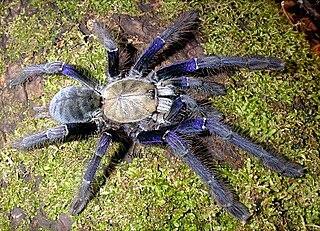
The South Australian cobbler, better known as the soldier but also known as the cobbler, devilfish or soldierfish, is a species of marine ray-finned fish, a waspfish, belonging to the subfamily Tetraroginae which is classified within the family Scorpaenidae, the scorpionfishes and their relatives. It is endemic to southern Australia. It is the only species in the monotypic genus Gymnapistes.

The Cordillera Blanca is a mountain range in Peru that is part of the larger Andes range and extends for 200 kilometres (124 mi) between 8°08' and 9°58'S and 77°00' and 77°52'W, in a northwesterly direction. It includes several peaks over 6,000 metres (19,690 ft) high and 722 individual glaciers. The highest mountain in Peru, Huascarán, at 6,768 metres (22,205 ft) high, is located there.

Lake Conococha is a South American lake located in the Andes mountains of northwestern Peru. It is located in the region of Ancash near the junction of the roads going from Callejón de Huaylas to Chiquián.
Bryantella is a genus of jumping spiders that was first described by Arthur Merton Chickering in 1946. As of June 2019 it contains only two species, found only in Brazil, Argentina, and Panama: B. smaragda and B. speciosa. This genus was named in honour of Elizabeth B. Bryant.

Pamphobeteus is a genus of tarantulas that was first described by Reginald Innes Pocock in 1901. It includes some of the largest spiders in the world. They are found in South America, including the countries of Peru, Bolivia, Ecuador, Brazil, Colombia and Panama.
Niceforonia lucida is a species of frog in the family Strabomantidae. It is endemic to Peru and known from the Cordillera Central west of the Apurímac River in the Ayacucho Region. Common name Cannatella's Andes frog has been coined for it. The specific name lucida refers to distinctive coloration of this frog relative to frogs in the genus Phrynopus, the genus where this species was initially placed. However, later studies have moved it to other genera where its colors are less distinctive.
Lynchius nebulanastes is a species of frog in the family Strabomantidae. It is endemic to north-western Peru where it is known from the vicinity of its type locality, El Tambo, on the western slope of the Cordillera de Huancabamba, Piura Region. Common name Canchaque Andes frog has been coined for it.

Pteroidichthys amboinensis, the Ambon scorpionfish or Godfrey's scorpionfish, is a species of marine ray-finned fish belonging to the family Scorpaenidae, the scorpionfishes. It is found in the Indian and Pacific oceans.

Tarantulas comprise a group of large and often hairy spiders of the family Theraphosidae. As of December 2023, 1,100 species have been identified, with 166 genera. The term "tarantula" is usually used to describe members of the family Theraphosidae, although many other members of the same infraorder (Mygalomorphae) are commonly referred to as "tarantulas" or "false tarantulas". Some of the more common species have become popular in the exotic pet trade. Many New World species kept as pets have setae known as urticating hairs that can cause irritation to the skin, and in extreme cases, cause damage to the eyes.

Thrixopelma is a genus of South American tarantulas that was first described by Günter E. W. Schmidt in 1994. They are medium to large tarantulas, usually being 35mm to 60mm in body length.
Rhinoplocephalus is a genus of snake in the family Elapidae. The genus is monotypic, containing the sole species Rhinoplocephalus bicolor, known commonly as the square-nosed snake, Müller's snake, or Muller's [sic] snake. The species is endemic to south-western Australia.
Cardiopelma is a genus of spiders in the family Theraphosidae. It was first described in 1999 by Vol. As of 2017, it contains only one species, Cardiopelma mascatum, known only from Mexico, in the state of Oaxaca.

Lampropelma is a genus of Indonesian tarantulas that was first described by Eugène Louis Simon in 1892. As of March 2020 it contains two species, found in Indonesia.
Phormingochilus is a genus of Indonesian tarantulas that was first described by Reginald Innes Pocock in 1895. They are occasionally kept as exotic pets, and are known for moving in bursts of speed and being defensive when cornered.

Omothymus is a genus of spiders in the family Theraphosidae, found in Malaysia, Indonesia and Singapore.

Rhinopias xenops, the strange-eyed scorpionfish, is a species of marine ray-finned fish belonging to the family Scorpaenidae, the scorpionfishes. This species is found in the Pacific Ocean.

The mangrove waspfish, also known as the goblinfish, is a species of marine ray-finned fish, a waspfish belonging to the subfamily Tetraroginae, which is classified as part of the family Scorpaenidae, the scorpionfishes and their relatives. This species occurs in the Indo-Pacific region.
Cymbiapophysa is a genus of spiders in the family Theraphosidae, first described by Pocock, in 1903, as of 2022 it contains 4 species. The tarantulas of this genus inhabit Central America. Males of this genus can be distinguished by the presence of a distal retrolateral apophysis on the cymbium of the male pedipalp. And females can be distinguished with twin spermathecae, by the morphology and the short and squat receptacles.
Umbyquyra gurleyi is a tarantula in the genus Umbyquyra, it is found in Brazil in Goiás in the National Park "Emas", it was first described by Danniella Sherwood and Ray Gabriel in 2020. It was named in honor of American herpetologist Russ Gurley, for his contributions and friendship to the authors.
Murphyarachne is a monotypic genus of Peruvian tarantulas, with one species, Murphyarachne ymasumacae. It was first described by Sherwood and Gabriel in 2022. The genus is named after Frances Mary Murphy and John Alan Murphy for their contributions to arachnology, and the Greek term "arachne", which is the word for spider.











